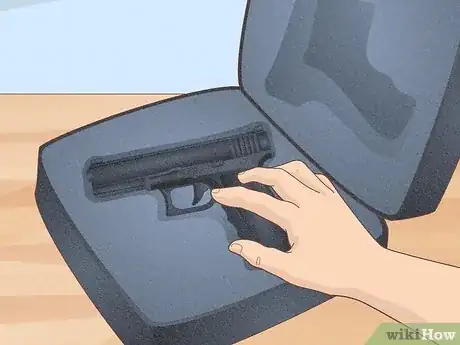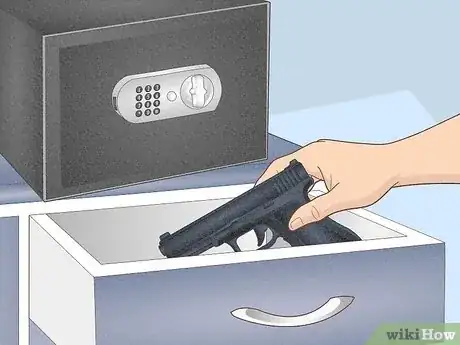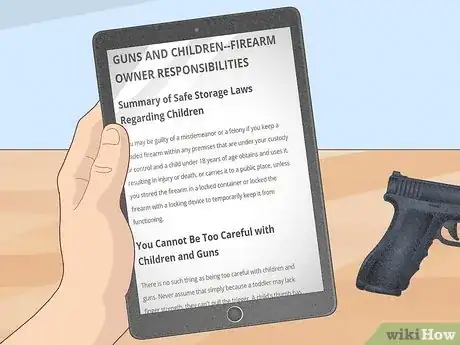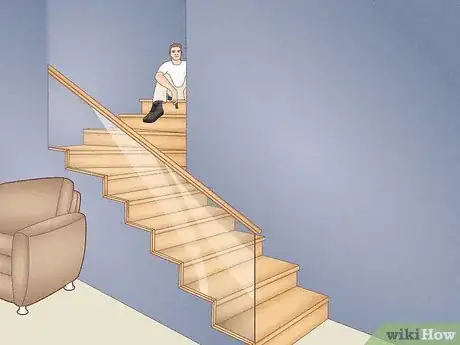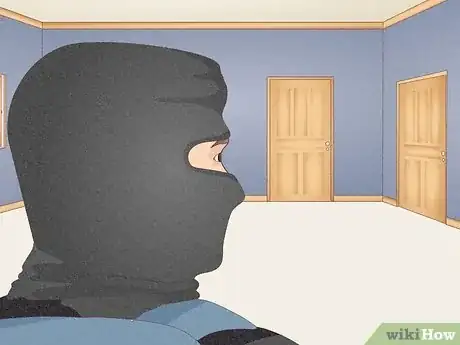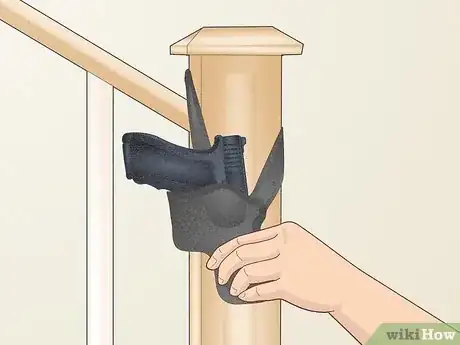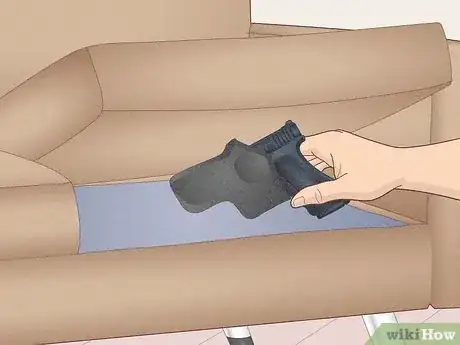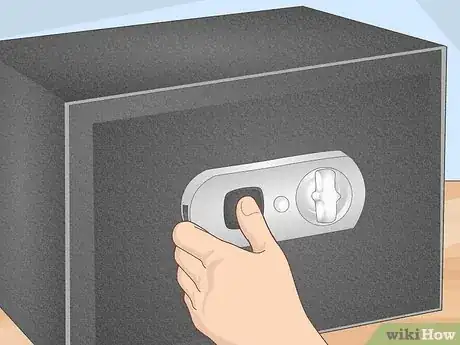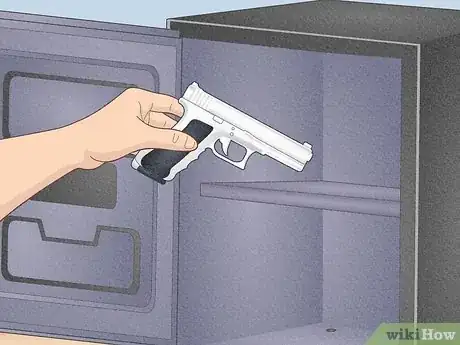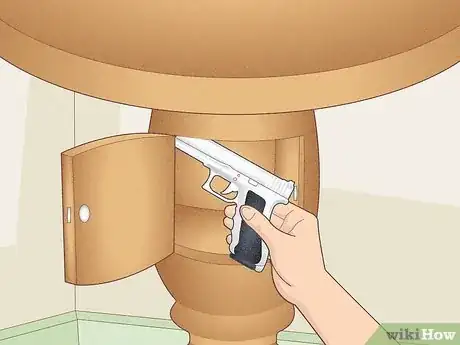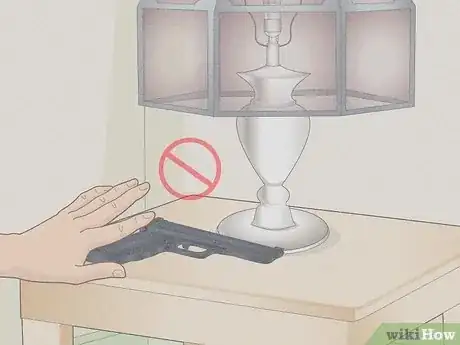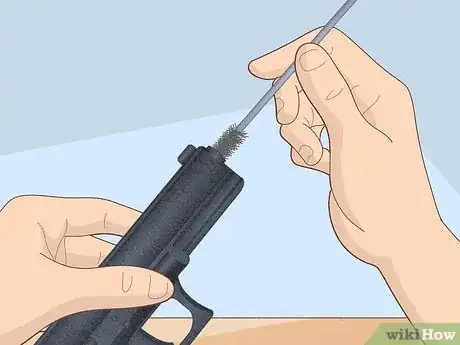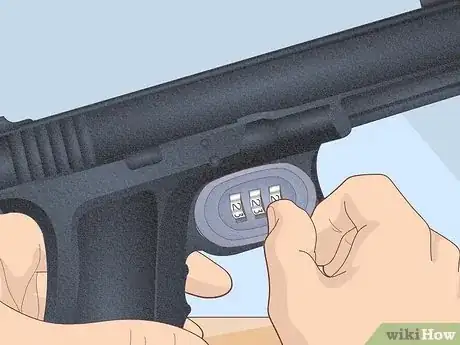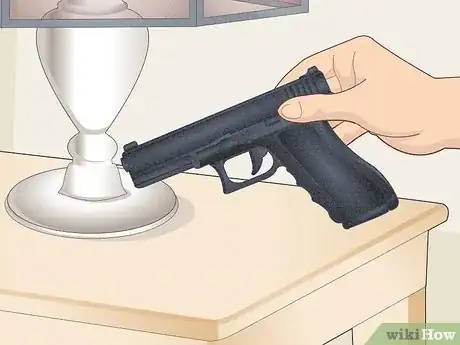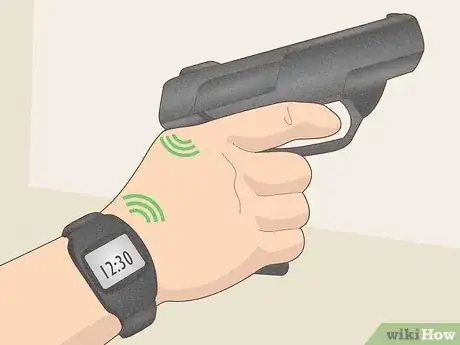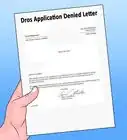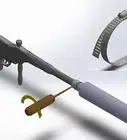This article was co-authored by Bryan Villella and by wikiHow staff writer, Jessica Gibson. Bryan Villella is the Lead Firearms Instructor and Owner of Don't Be A Sitting Duck in Kissimmee, Florida. Bryan has nine years of professional experience and is an NRA and Florida State Certified “K” Instructor. He leads certified training courses necessary to get licensed through the state to work in the private security field. He prioritizes safety and building comfortable environments for people to learn skills safely.
There are 11 references cited in this article, which can be found at the bottom of the page.
This article has been viewed 3,028 times.
If you’re storing a handgun in your house, especially for self-defense, you probably already know that it’s a huge responsibility. So how can you be sure you’re making the safest possible storage decision? You've got to find a balance between quick access and secure storage, especially since accidents can happen if a gun is improperly stored. We’ll cover absolutely everything you need to know about handgun storage, so you can feel confident that your home is totally safe and protected.
Steps
Practicing Gun Safety in Your Home
-
1Gun storage is an important decision—so think it through carefully. When guns aren't properly stored, dangerous accidents can follow. Plus, you're responsible for your firearms, especially if there are kids around or you have visitors in your home. Your guns should never be within reach of your children.[1] X Research source
-
2Create an emergency plan and share it with family members. Inform other adults about where handguns are staged in your home—if you've locked a safe, let them know where the keys are. Have a discussion with all of your family about what to do in the event of a break-in. You might discuss a meeting point or assign tasks like calling the police.[2] X Research source
- It might help to have a list of what to do pinned to a wall or safe, so you don't panic in the event of a home invasion. Keep your action list short and simple.
- Practice gun safety when you're defending yourself from an intruder—don't put the finger on the trigger until you spot the target and you've looked beyond the target in your sight. Remember to make gun safety part of your intruder plan.
Advertisement -
3Safe storage includes educating kids in your home about gun safety. Pick a time when you can talk to the kids without distractions and tailor your conversation so it's age-appropriate. For young kids, point out simple rules like "If you see a gun, stop and don't touch it." For older kids or teens, stress that they should never pick up or handle a gun without an adult's permission and supervision.[3] X Research source
- Tell younger kids that if they find a gun, they should leave it and go tell an adult.
- Teach older kids to always assume that a gun is loaded and to never point a gun at anyone.
- Bring up the topic of gun safety often. By reminding kids, you're stressing how important it is.
Considering Your Personal Circumstances
-
1Decide if storing the gun makes more sense for you than staging it. Storing means that the handgun is locked in a secure location away from kids or anyone visiting your home while staging means it's in an easy-to-access location, so it's ready for emergency use. Staging might make sense if you're worried about a home invasion. If you have kids at home and prioritize safety over accessibility, storage might be a better option. [4] X Research source
-
2Read up on your local gun storage laws. Some jurisdictions require you to lock your guns up when you're not using them while others allow for open storage. In some areas, you could be charged with a misdemeanor or felony if kids have access to firearms and harm someone.[5] X Research source
- The laws vary wildly from state to state, which is why it's so important to learn the specific laws in your area.
-
3Think about your home layout and find easily defendable positions. These are spots in your home that you can quickly get to and that will give you an advantage when it comes to seeing an intruder approach. For instance, you might stage a weapon in a bedroom at the top of the stairs or at the end of a hallway because you'll have time to prepare as the intruder climbs steps or walks the length of the hallway.[6] X Research source
- If you've got multiple handguns for self-defense, you'll have more options for staging the weapons throughout your home.
-
4Identify where thieves or intruders would go if they break-in. Most thieves will head straight to a bedroom—they often look for a master bedroom where jewelry or valuables might be stored—but they may mistake a guest bedroom for the master. They'll also head for the home office, living room, and dining room since valuables might be displayed there.[7] X Research source
- These are all locations where you might want to stage a handgun.
Where to Store Guns in Your Home
-
1Weigh the risks of easy access and safety if you keep the gun exposed. If you have the gun setting out or you have it holstered and you're carrying, you obviously can get to the gun quickly. However, this is a risky option since you could accidentally injure yourself, someone could steal your firearm and even use it against you, visitors could be negligent with it, and kids could pick it up.
- Open storage or carrying is impractical most of the time. Plus, some states have storage laws that require guns to be locked when not in use.[8] X Research source
-
2Place the handgun in a central location at your home. In an emergency, you should be able to quickly access your handgun, so think about where you spend the most time in your home and where you'd most likely be during the event of a home invasion. If you have more than one handgun, you can stage them in multiple locations. Here are a few of the most useful locations for staging them:[9] X Research source
- Guest or master bedroom: For the most secure storage, use a safe under the bed or conceal it in your headboard. For easier access, store it in your locked nightstand or a soft holster instead.
- Home office: Store the handgun in a desk drawer, so you can easily get it if you're in the room or conceal it in a hollow book for secretive storage.
- Living room: Place the gun in a soft holster under your couch or armchair—don't forget to use a trigger lock so the gun doesn't accidentally discharge, or hide the gun in concealed furniture.
- Kitchen pantry: Place a small gun safe in the pantry since most thieves won't think to look there.
- Closet near an exit door: Thieves also overlook closets and by storing the gun in a safe near the door, you can arm yourself and get out.
-
3Conceal the handgun in a biometric safe. You don't want to leave the handgun out in the open—it could be stolen, accidentally discharge, or be used against you. Instead, keep your handgun in a biometric safe. These come in a variety of sizes, so you can find one to fit the space. To open a biometric safe, you'll need to scan your fingerprints, retinas, or face, so it's unique to you.[10] X Research source
- For example, put a small biometric safe on your kitchen counter next to your appliances or one on your bookshelf in a bedroom or living room.
-
4Place the handgun into a locked gun cabinet or vault. To be absolutely sure that no one can access your handgun, put it into a secure storage unit that can't be removed. For added security, store the ammunition in a locked location that's separate from the handgun.[11] X Research source
- If you've got other guns that you use infrequently, store them in the locked safe, gun cabinet, or vault, too.
-
5Hide the handgun in concealed furniture or false walls. If you don't want to place your gun in a biometric lock box, purchase furniture like small tables, wall clocks, or bookshelves that contain a small, concealed lockable gun safe. These blend in really well, so intruders won't suspect that you have a home defense handgun.[12] X Research source
- You can buy bedside tables, headboards, or wall-mounted mirrors that have hidden compartments where you can lock your handgun.
-
6Avoid storing your gun on your nightstand or anywhere it could go off. You don't want to accidentally knock it over in the dark or make it easy for kids to access the gun. You should also avoid storing your handgun under your mattress or pillow or on a closet shelf (where curious kids could find it).[13] X Research source
- Don't store your firearms with your other valuables like jewelry or cameras unless you can lock them all in a safe.
How to Store Guns Safely
-
1Remove the rounds for the safest way to store the handgun. If your priority is gun safety, take the ammunition out of the handgun before you put it into storage.[14] X Research source In an emergency, you would have to take time to load the handgun, but this is a personal decision that you'll have to make.
- Some people choose to store their handgun with a round in the chamber—this cuts loading time in a potential emergency, but it does mean that the gun is loaded—something to consider if it falls into the wrong hands.
-
2Clean your handgun before you put it into storage. Keep your gun in good working order to maintain it during storage. This way you're safer in an emergency. Remove the ammunition and disassemble the gun according to the manufacturer's instructions. Then, clean, dry, and lubricate the handgun. Light lubrication can prevent rust, which is important if you're storing the handgun for a while.[15] X Research source
- Clean your gun in a well-ventilated space, so you don't breathe in fumes from the cleaning solvents.
- Consider doing a monthly shooting test to ensure that your handgun is in good shape.
-
3Put a trigger or cable lock on the gun to prevent an accidental discharge. Both of these keep a gun from going off by blocking the gun's firing mechanism. To use a trigger lock, fit the two-piece device around the trigger, so you can't pull it. To use a cable lock, slide a steel cable through the magazine well and loop it into the lock that you secure with a key.[16] X Research source
- You can get free cable locks or trigger locks from most police departments. Go to https://projectchildsafe.org/safety/get-a-safety-kit/ to check.
-
4Store the gun horizontally or with the muzzle pointed down. It's good to be in the habit of pointing the handgun's muzzle in a safe direction so that even if it accidentally discharged, no one would be injured.[17] X Research source
- Remember to point the muzzle away when you go to pick up the firearm.
-
5Invest in childproof guns that only work when you hold them. Childproof guns are also called smart guns—they use either radio frequency identification or biometric recognition like a fingerprint reader in order to operate. This way, no one other than the gun owner can use the handgun.[18] X Trustworthy Source PubMed Central Journal archive from the U.S. National Institutes of Health Go to source
- Smart guns are a good option if you've got kids in the home or other adults that you don't want to have access to your weapon.
Warnings
- Always follow responsible gun ownership and practice firearm safety. Never point the gun at anything you don't intend to harm.⧼thumbs_response⧽
- Keep your finger off of the trigger unless you're ready to actually shoot.⧼thumbs_response⧽
You Might Also Like


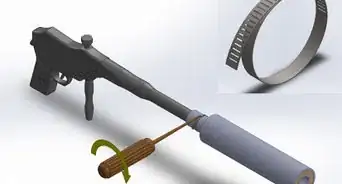
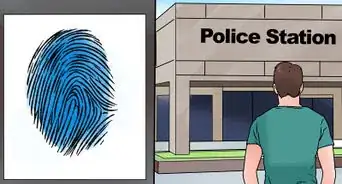


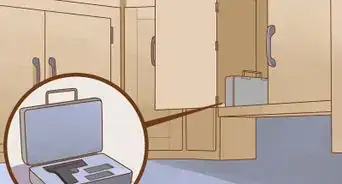
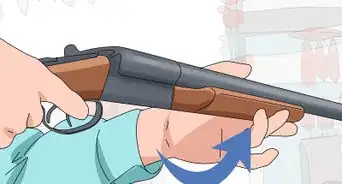
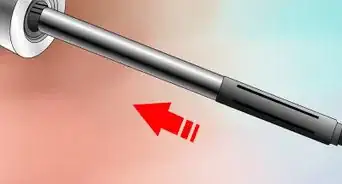



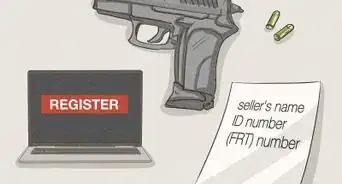

Expert Interview

Thanks for reading our article! If you'd like to learn more about storing a firearm, check out our in-depth interview with Bryan Villella.
References
- ↑ https://www.healthychildren.org/English/safety-prevention/at-home/Pages/Handguns-in-the-Home.aspx
- ↑ https://louisianabaptists.org/wp/wp-content/uploads/2021/09/Home-Defense-CHECKLIST.pdf
- ↑ https://youtu.be/M86QxNZF3AE?t=155
- ↑ https://www.healthychildren.org/English/safety-prevention/at-home/Pages/Handguns-in-the-Home.aspx
- ↑ https://oag.ca.gov/firearms/tips
- ↑ https://youtu.be/8VO6-fYiA0w?t=735
- ↑ https://www.waltongas.com/10-home-security-facts-that-burglars-hope-you-wont-read/
- ↑ https://oag.ca.gov/firearms/tips
- ↑ https://gunsafecoach.com/where-to-keep-gun-for-home-defense/
- ↑ https://projectchildsafe.org/wp-content/uploads/files/PCS_SafeStorage_19.pdf
- ↑ https://projectchildsafe.org/wp-content/uploads/2020/05/PCS_FirearmsSafety_2020_web.pdf
- ↑ https://gunsafecoach.com/where-to-keep-gun-for-home-defense/
- ↑ https://oag.ca.gov/firearms/tips
- ↑ https://www.healthychildren.org/English/safety-prevention/at-home/Pages/Handguns-in-the-Home.aspx
- ↑ https://www.americanfirearms.org/how-properly-clean-store-your-guns/
- ↑ https://oag.ca.gov/firearms/tips
- ↑ https://projectchildsafe.org/wp-content/uploads/2020/05/PCS_FirearmsSafety_2020_web.pdf
- ↑ https://www.ncbi.nlm.nih.gov/pmc/articles/PMC4815965/
About This Article

